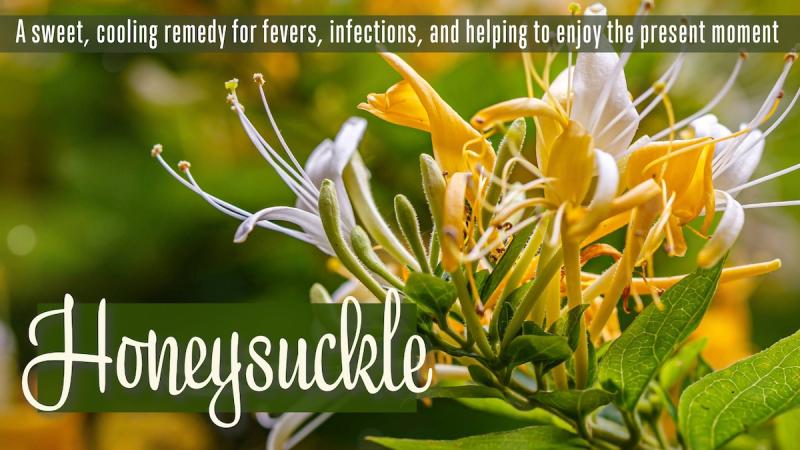
One of the things I love about spring is smelling all the wonderful flowers on the trees and bushes. One of my favorites is honeysuckle. It has a delightfully sweet fragrance, in total harmony with the honey in the plant’s name.
Honeysuckle is more than just a beautiful flowering shrub or vine. It is also a useful herbal medicine. While, there are over 150 species in the Lonicera genus listed on Wikipedia, only a few are used for medicine. The main species used in traditional Chinese medicine (TCM) is Japanese honeysuckle (Lonicera japonica), but other species have been used including L. caprifolium. Native American Ethnobotany by Daniel E. Moerman lists another eleven species used by Native Americans, including two species that grow in my home state of Utah, twinberry honeysuckle (L. involucrata) and Utah honeysuckle (L. utahensis), but what I'm writing about applies primarily to Japanese honeysuckle (L. japonica), which is often grown as an ornamental plant and has taken root in the wild as well, to the point of being invasive in some areas of the world.
Medicinal Actions of Honeysuckle Flowers
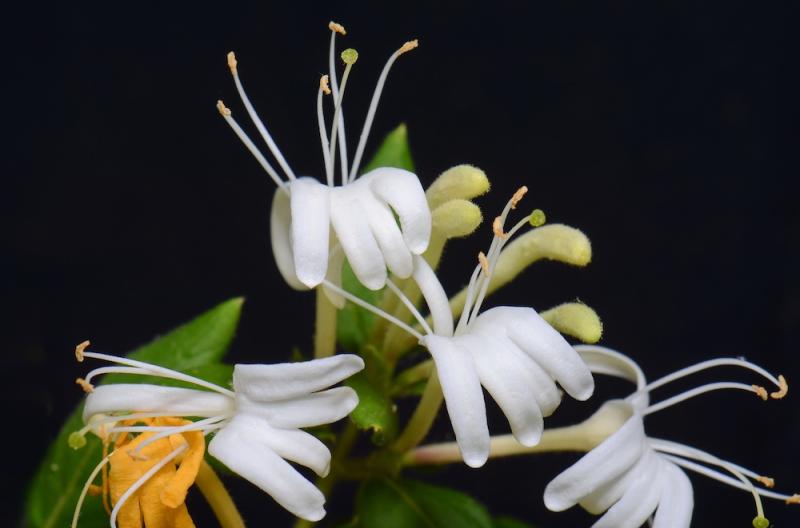 Honeysuckle flower buds and flowers are used in TCM to clear toxins and reduce heat. They are used for treating fevers caused by infections and are considered to be most effective when used in the early stages of the fever. They may be helpful with fever associated with sore throats, colds, and influenza. The flowers have antibacterial effects, but the antibacterial action is stronger in the leaves.
Honeysuckle flower buds and flowers are used in TCM to clear toxins and reduce heat. They are used for treating fevers caused by infections and are considered to be most effective when used in the early stages of the fever. They may be helpful with fever associated with sore throats, colds, and influenza. The flowers have antibacterial effects, but the antibacterial action is stronger in the leaves.
With its cooling nature, honeysuckle flower can be used to reduce fever and relieve inflammatory conditions. It is often combined with chrysanthemum flowers as a cold remedy. It is also used to ease gastrointestinal inflammation associated with infectious diarrhea and to treat infections on the skin, including abscesses and sores with pus.
The flowers are also mildly stimulating, increasing the activity of the central nervous system. The stimulating effect is said to be about 1/6 of that of caffeine. They can also be used as a beverage to reduce feelings of heat on hot summer days.
Honeysuckle Leaves and Bark
Honeysuckle leaves and bark have also been used as medicine. The leaves have a stronger antibacterial effect than the flowers and can be crushed and applied topically to help fight infections on the skin. The leaves and flowers have also been used topically for cuts, abrasions, and poison oak. Native Americans used the bark from honeysuckle species more than the leaves or flowers, but I do not have sufficient experience or information to know how to safely use them.
Honeysuckle Flower Essence
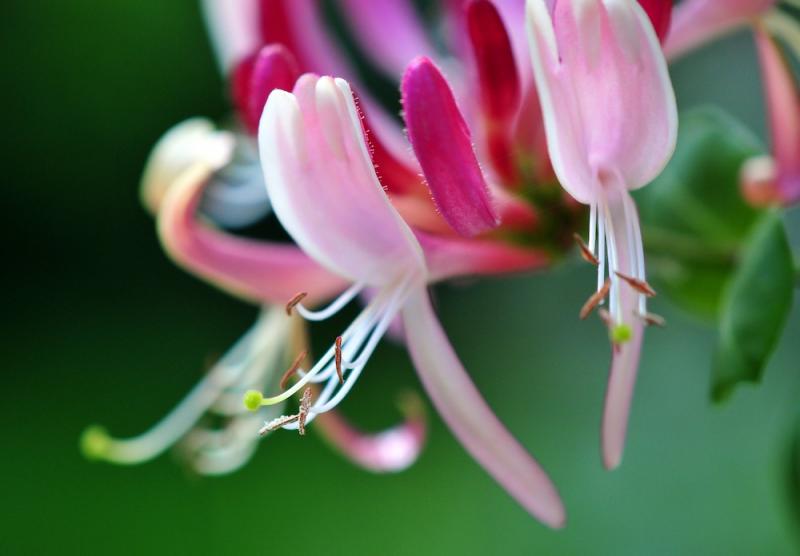
Honeysuckle is used as a flower essence, which is how I’ve used it the most. It is for helping with nostalgia, people who pine away for a past that they now perceive as having been better than the present. It helps bring a person back to the here and now and find more joy and happiness in the present moment. It also aids emotional clarity, so that a person learns lessons from their past experiences that they can use in their present life, while releasing their attachment to the past.
In that regard, honeysuckle is often a good flower remedy for elderly people who long for the days of their youth and want to “turn back the clock.” It’s interesting that honeysuckle is often combined with chrysanthemum for colds, because there is also a synergy between the flower essences. Chrysanthemum flower essence helps people who fear aging, so the combination of the two flower essences can help a person let go of their attachment to youth and accept the aging process, finding joy and purpose in their later years.
Honeysuckle Absolute
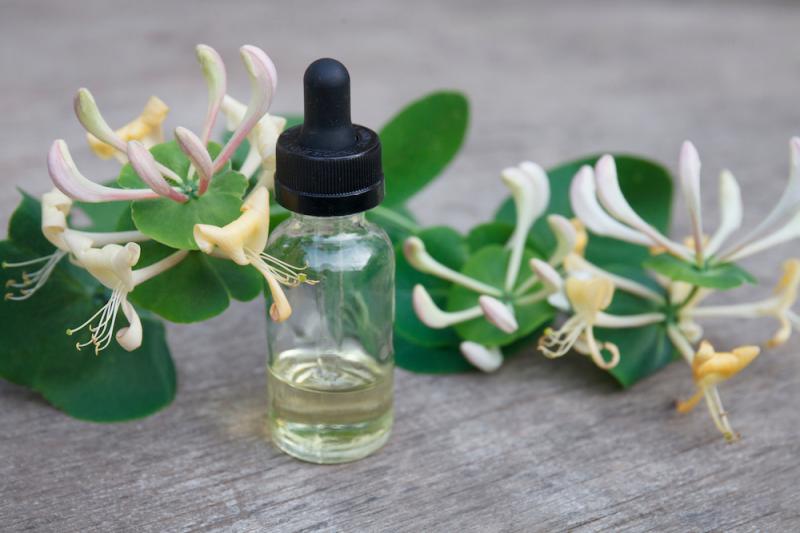 I also have a honeysuckle perfume oil that I’ve used for similar purposes to the flower essence. Smelling honeysuckle always seems to open up the childlike feelings of happiness for me. It reminds me of happy times and opens my heart and feelings. The fragrance is sweet, floral and calming. It eases anxiety and nervousness and like the flower remedy helps nostalgic people who long for the past to find joy and happiness in the present.
I also have a honeysuckle perfume oil that I’ve used for similar purposes to the flower essence. Smelling honeysuckle always seems to open up the childlike feelings of happiness for me. It reminds me of happy times and opens my heart and feelings. The fragrance is sweet, floral and calming. It eases anxiety and nervousness and like the flower remedy helps nostalgic people who long for the past to find joy and happiness in the present.
It's also one of the fragrances I use to help people who are overly stoic because they grew up too fast, taking on adult responsibilities at a very early age. Lacking the opportunity of being able to play and enjoy their childhood, they find it difficult to laugh, allow themselves to experience pleasure, or to spend time in recreation. They tend to be overly serious, workaholic. Honeysuckle can help them reconnect with what I call the playful, inner child, so they can find more joy and happiness in present life.
Using Honeysuckle
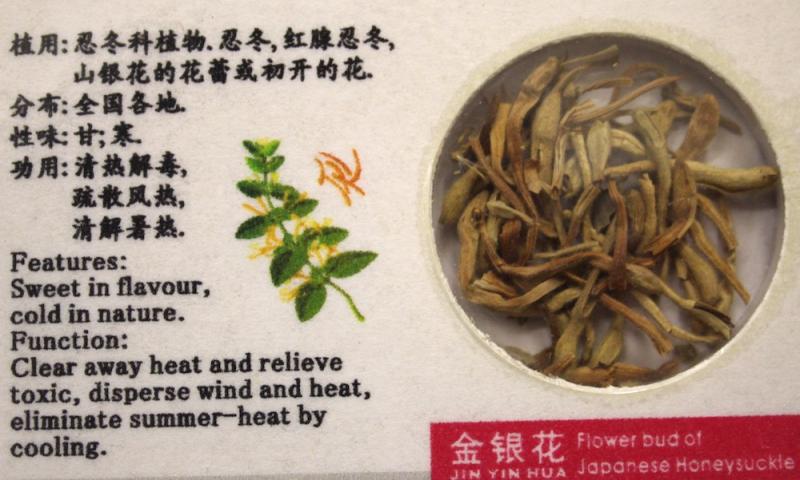
When using honeysuckle, make sure you identify the species as there are reports that some species are toxic. Gather the fresh flowers or the flower buds and dry them. The traditional Chinese use is 10-20 grams made into a decoction, but you can also make a tea from them. Use 1-2 teaspoons of flowers per cup, steep for 8-10 minutes, and drink several cups a day. This is particularly helpful at the onset of a fever.
The plant can also be found in various herbal formulas for viral infections, respiratory infections, and inflammation. I’ve used a Chinese Heat-Clearing formula that contains honeysuckle flower buds, forsythia fruits, and chrysanthemum flowers as primary ingredients. I’ve successfully used it for earaches, fevers, sore throats, and other acute, inflammatory conditions.
To utilize the emotional benefits of honeysuckle use the flower essence or the perfume oil. Use caution applying honeysuckle absolute topically as it can irritate the skin and may increase phytosensivity.
Steven's Articles
-

-
The Evidence for Berberine
A yellow alkaloid found in traditional infection-fighting…
-

-
The Sensible Use of Caffeinated Herbs
Kola nuts, guarana, and yerba mate and other herbs…
-

-
The Health Benefits and Problems with Coffee
This popular caffeinated beverage can be beneficial…
October
-

-
Understanding Caffeine & Cellular Adaptation
Preserving the power of caffeine's buzz and the…
September
-

-
Horseradish
A pungent spice for aiding protein metabolism…
-

-
Banaba or Crepe Myrtle
A beautiful tree from Southeast Asia whose leaves…
August
-

-
Monkeyflowers
Flower essences to help see ourselves more clearly…
-

-
Mariposa Lilies
Strengthening the bond between mother and child…
-

-
The Noble Bay Leaf
A common kitchen herb for aiding digestion and…
-

-
Epimedium: Horny Goat Weed
A circulatory stimulant and kidney yang tonic…
July
-

-
The Medicinal and Nutritional Benefits of Apricots
A nutritious fruit and valuable medicinal seed for coughs
-

-
Dogwoods
Asian dogwood is used to stop excessive discharge,…
June
-

-
Neem: The Village Pharmacy
A popular Ayurvedic remedy for dental and immune…
-

-
Spilanthes: The Toothache Plant
A traditional remedy for teeth and gums, as well…
-

-
Forsythia
An anti-inflammatory, fever-reducing, and infection fighting herb

